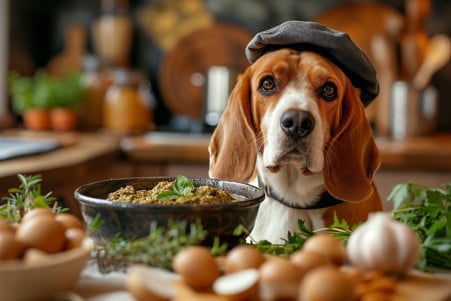Can Dogs Eat Garlic Bread? The Risks Explained
3 May 2024 • Updated 1 May 2024

While your dog may be enticed by the smell of garlic bread, there are some risks and precautions to be aware of when it comes to sharing this human food with your pet. Garlic is toxic to dogs, even in small doses, because it contains allium, a compound that can cause damage to a dog's red blood cells and result in anemia. As a result, it's best to avoid giving your dog garlic bread and instead stick to the foods that are part of the veterinarian-recommended pet diet.
In this article, we'll take a closer look at the findings of expert veterinarians and pet nutritionists who have studied the compounds in garlic that are harmful to dogs. Their research can help pet parents make sure they're being responsible when it comes to avoiding foods that contain garlic and knowing the signs of toxicity. We'll also discuss some healthy treat alternatives that can help you satisfy your dog's cravings without putting their health at risk.
Can dogs eat garlic bread?
How Garlic Is Toxic to Dogs
Garlic's toxicity to dogs is due to the presence of compounds such as thiosulfates, which can cause oxidative damage to red blood cells when they are broken down in the liver. This can result in a condition called hemolytic anemia, which is characterized by a lack of red blood cells to carry oxygen throughout the body, according to PetMD.
Symptoms of garlic poisoning in dogs can also include gastrointestinal upset (e.g., vomiting, diarrhea, abdominal pain), weakness, rapid breathing and heart rate, and discolored urine. The amount of garlic that needs to be consumed to cause these symptoms can vary, but even small amounts can be dangerous, especially to dogs that are more susceptible to garlic poisoning.
It's important to note that the danger of garlic poisoning isn't limited to fresh garlic—garlic powder, cooked garlic, and other processed forms can also cause oxidative damage to a dog's red blood cells and other health problems. That's why garlic bread, which combines garlic with other ingredients that are high in fat and other potentially harmful substances, is definitely not a good idea as a treat for our four-legged friends. If you suspect your dog has eaten garlic, it's important to know the symptoms of garlic poisoning and to seek veterinary care immediately.
How to Tell If Your Dog Has Garlic Poisoning
The symptoms of garlic poisoning are not always immediate and can take a few days to show up. The PDSA lists the most common symptoms as vomiting, diarrhea, loss of appetite, and depression. If your dog has eaten garlic, it's important to call your vet right away.
Treatment can include vomiting, activated charcoal, and supportive care, according to WagWalking. Most dogs will recover fully with treatment, but in some cases, garlic poisoning can be life-threatening. In addition, VCA Animal Hospitals warns that some breeds, including Akitas and Shiba Inus, may be more susceptible to the effects of garlic poisoning.
Healthy and Safe Human Snacks for Dogs
Although garlic bread is not an option, there are plenty of healthy and safe human snacks that dogs can eat. Petco lists a number of healthy snacks including plain cooked meats, vegetables like carrots and sweet potatoes, and some fruits. Dairy products like cheese and yogurt can also be eaten in moderation, unless the dog is lactose intolerant.
Of course, there are also a number of human foods that are toxic or unhealthy for dogs, including chocolate, grapes, and salty or sugary snacks. According to Medical News Today, onions, garlic, and macadamia nuts are also toxic to dogs. Dogs should also only eat human snacks in moderation, as their main source of nutrition should come from a balanced commercial dog food.
Why Responsible Pet Ownership and Nutrition Matter
For pet parents, it's important to understand the risks associated with certain human foods for dogs. According to Purina, garlic, onions, and other Alliums are particularly dangerous and should be kept away from dogs. Even small quantities of these items can be poisonous and result in health problems such as anemia.
While it's fine to give dogs the occasional treat, their main source of nutrition should be a well-balanced, high-quality commercial dog food. As FetchPet notes, garlic in all forms - raw, cooked, and processed - is harmful to dogs. Working with a vet can help pet parents make sure that they're meeting their dog's dietary requirements in a way that's safe and healthy.
Part of being a responsible pet parent is understanding the risks and making sure that dogs are getting the nutrition they need to thrive. This means being aware of potential dangers and making sure that dogs are getting the nutrition they need to be healthy. By understanding the risks and making sure that dogs are getting the nutrition they need to thrive, pet parents can make sure that their dogs stay healthy and happy and avoid the risks of garlic bread and other toxic human foods.
Conclusion: Why Garlic Bread Shouldn't Be Fed to Dogs
The toxic effects of garlic on dogs are due to the presence of compounds like thiosulfates, which can cause oxidative damage to red blood cells when they're metabolized. This can result in hemolytic anemia, which is when the body doesn't have enough healthy red blood cells to carry oxygen, according to PetMD.
Other potential symptoms include gastrointestinal upset such as vomiting, diarrhea, and abdominal pain, as well as weakness, increased heart and respiratory rates, and dark urine. The toxic dose can vary, but even small amounts can be dangerous, especially for dogs that are more susceptible to garlic toxicity.
Importantly, the risk isn't limited to raw garlic - powdered, cooked, and processed forms can also cause oxidative damage to red blood cells and negatively impact a dog's health. As a result, garlic bread, which contains a combination of garlic and other potentially toxic ingredients, should be off-limits as a snack for our furry friends. Knowing the symptoms and getting immediate veterinary help is important if accidental exposure occurs.


